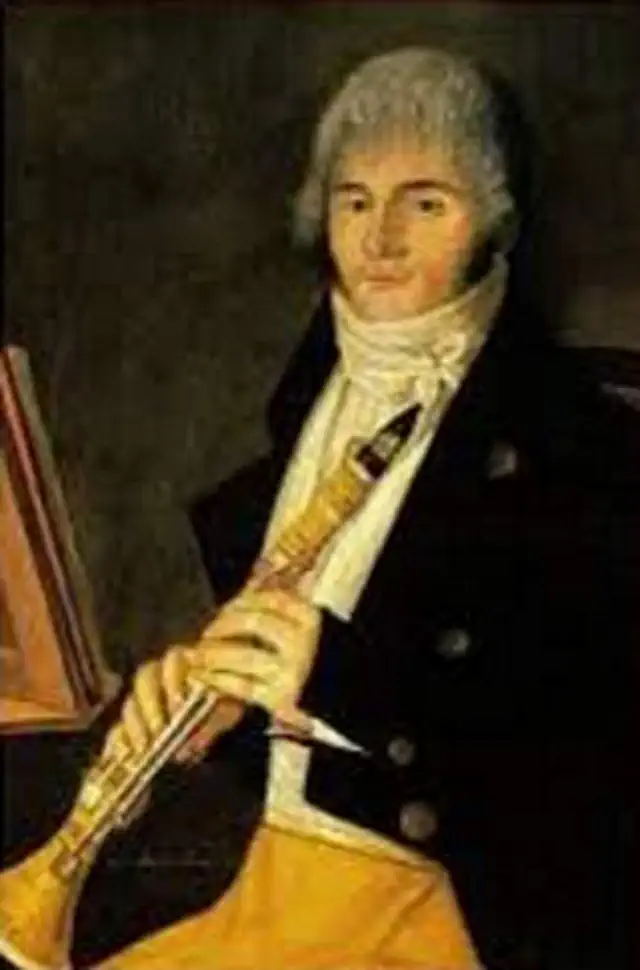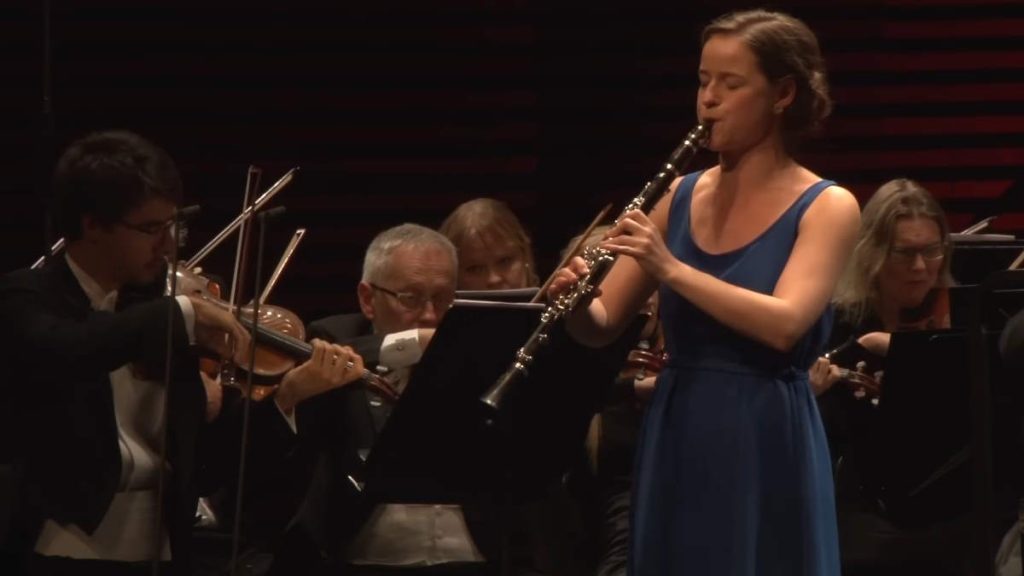Accompanied by the Gimnazija Kranj Symphony Orchestra, the Slovenian clarinetist Nadja Drakslar performs Wolfgang Amadeus Mozart’s Clarinet Concerto in A major, K. 622. Conductor: Primož Zevnik. Recorded during the Gimnazija Kranj Great Christmas Concert, 2011.
Mozart’s Clarinet Concerto
Wolfgang Amadeus Mozart’s Clarinet Concerto in A major, K. 622, is one of his final completed works, written in 1791, the last year of his life. This concerto is renowned for its lyrical beauty and is considered one of the greatest works ever composed for the clarinet. It was specifically composed for the clarinetist Anton Stadler (28 June 1753, Bruck an der Leitha – 15 June 1812, Vienna), a friend of Mozart and a virtuoso musician. Stadler’s mastery of the instrument inspired Mozart to explore its full range of capabilities and expressions, which is vividly showcased in this concerto.
The concerto is noted for its melodic richness and emotional depth, blending Mozart’s classic elegance with a sense of serene introspection. It stands out for its smooth and flowing lines that highlight the clarinet’s warm tones and the natural singing quality of the instrument. Mozart’s use of the clarinet not only emphasizes its soloistic qualities but also integrates it beautifully with the orchestra, creating a dialogue that is both sophisticated and touching.
The composition’s enduring popularity is a testament to its artistic achievement, appealing to both classical music enthusiasts and the general public. Its premiere was met with considerable acclaim, and it has since become a staple of the clarinet repertoire, celebrated for its technical demands and its expressive range. Mozart’s Clarinet Concerto remains a profound expression of his genius, combining clarity of form with depth of feeling, making it a beloved piece in the classical music canon.

Mozart’s Clarinet Concerto was written to be played on the basset clarinet, which can play lower notes than an ordinary clarinet, but after the death of Mozart, it was published with changes to the solo part to allow performance on conventional instruments. The manuscript score is lost, but from the latter part of the 20th century onwards, many performances of the work have been given on basset clarinets in conjectural reconstructions of Mozart’s original.
Since there are no surviving instruments from Mozart’s lifetime. The oldest ones are from the early 19th century. What Anton Stadler’s instrument looked like, the instrument that Mozart saw, was not known for a long time. But, in 1992, an American musicologist discovered a drawing of Stadler’s basset clarinet in a program booklet for a concert that Stadler played when he was on tour in Riga, Latvia.
The instrument used by Stadler was invented and built by the Vienna K.K. court instrument maker Theodor Lotz around 1788.
Movements
1. Allegro
The first movement of Mozart’s Clarinet Concerto in A major, K. 622, is marked as Allegro. It opens with a graceful and engaging orchestral introduction that sets a lyrical and somewhat contemplative tone. This is followed by the entrance of the clarinet with a theme that is both expressive and ornate, showcasing the instrument’s full range of capabilities.
The movement is structured in a classical sonata form, consisting of exposition, development, and recapitulation, allowing for a detailed thematic exploration and development. In the exposition, the clarinet presents the main themes, which are melodic and richly adorned, demonstrating the clarinet’s ability to articulate quick passages and lyrical lines seamlessly. The development section further explores these themes, introducing variations and modulations that heighten the emotional depth of the piece.
The recapitulation brings back the main themes, now transformed and enriched by their earlier development, and leads to a cadenza. Typically, this cadenza, often improvised by the performer in Mozart’s time, is an opportunity for the soloist to display virtuosity and sensitivity, before concluding with a final statement of the main theme and a spirited coda that ends the movement on a lyrical high.
2. Adagio
The second movement of Mozart’s Clarinet Concerto in A major, K. 622, is marked as Adagio and is often noted for its profound beauty and emotional depth. This movement is a sublime example of Mozart’s ability to convey deep sentiment in music, with a gentle, flowing melody that fully exploits the clarinet’s lyrical capabilities.
In this movement, the clarinet sings a long, tender melody that unfolds over a subdued orchestral accompaniment, creating an atmosphere of serene contemplation. The music flows with a calm and introspective quality, showcasing the clarinet’s warm, singing tone. The orchestral backdrop is minimalist, allowing the solo clarinet to take center stage and engage the listener with its nuanced and expressive phrasing.
The mood of the Adagio is reflective and somewhat melancholic, reflecting perhaps the introspective period of Mozart’s life as this was one of his final compositions. The movement is structured simply but elegantly, maintaining a delicate balance between the soloist and the orchestra. The interaction is intimate as if the clarinet were engaged in a personal dialogue, making this movement particularly touching and memorable.
The Adagio from Mozart’s Clarinet Concerto remains one of the most cherished pieces in the classical repertoire, widely admired for its serene beauty and emotional resonance. It encapsulates the essence of Mozart’s late style, combining clarity, simplicity, and depth in a way that only he could achieve.
3. Rondo: Allegro
The third movement of Mozart’s Clarinet Concerto in A major, K. 622, is labeled “Rondo: Allegro.” This final movement brings a lively and spirited conclusion to the concerto, showcasing the clarinet’s agility and the composer’s playful, inventive musical ideas.
The Rondo follows a classical rondo form, characterized by a recurring main theme (the “refrain”) that alternates with contrasting sections (the “episodes”). The main theme is bright and joyful, with a dance-like rhythm that brings a buoyant energy to the movement. This theme is memorable for its catchy melody and the light-hearted, almost jubilant mood it sets.
As the movement progresses, each return of the rondo theme brings a sense of familiarity and coherence, while the intervening episodes explore new keys, moods, and melodic ideas. These episodes allow the soloist to display a variety of technical skills, including rapid passages, intricate figurations, and expressive nuances. The interplay between the clarinet and the orchestra remains lively and engaging throughout, with the orchestra providing a rich harmonic foundation that complements the soloist’s virtuosic display.
The Rondo concludes with a vigorous and cheerful coda that reiterates the main theme, ending the concerto on an uplifting and exuberant note. This movement not only highlights the clarinet’s capabilities as a solo instrument but also exemplifies Mozart’s mastery in crafting music that is both sophisticated and delightfully entertaining. The final Rondo is a fitting end to the concerto, leaving the audience with a sense of joy and admiration for the composer’s musical genius.
Nadja Drakslar Petrač
Clarinetist Nadja Drakslar Petrač studied clarinet at the Ljubljana Academy of Music in the class Ord. Prof. Alojza Zupana. She graduated with honors
in 2010.
She completed her Master’s degree at the Graz University of Arts (Kunstuniversitat Graz).
She graduated from Gerald Pachinger with an excellent grade in October 2013. During her studies, she regularly attended master classes of internationally renowned clarinetists including Mate Bekavac, Sharon Kam, Michel Lethiec, Philippe Berrod, and Stephen Williamson, and international summer of chamber music schools, performed in various chamber music schools ensembles. She also regularly prepared independent recitals and participated in various festivals and projects.

After successful auditions, she also participated in several international orchestras, the most prestigious of which was the Pacific Music Festival Orchestra in Japan.
As a soloist, Nadja Drakslar Petrač performed as part of the concert subscription of the Academy of Music with the Symphony Orchestra of RTV Slovenia and the Orchestra SNG Opera and Ballet Ljubljana.
Her performance of Carl Weber’s Clarinet Concerto No. 2 in E♭ major, Op. 74 with the Symphony Orchestra of RTV Slovenia under the baton of conductor Rene Gulikers, in 2007 received a new award from the Academy of Music.
Now Nadja DRAKSLAR PETRAČ works as a clarinet professor at the School of Music Kočevje and the Litija Music School and devotes herself to her sons.
Sources
- Clarinet Concerto (Mozart) on Wikipedia
- Wolfgang Amadeus Mozart: Concerto in A Major for basset clarinet and orchestra, K. 622 on the Boston Baroque website
- Clarinet Concerto in A major, K. 622 (Mozart, Wolfgang Amadeus) on the International Music Score Library Project website

![Mozart Clarinet Concerto [Sharon Kam]](https://cdn-0.andantemoderato.com/wp-content/uploads/2016/08/Sharon-Kam-Mozart-Clarinet-Concerto-1024x576.jpg)



Please give more personal information on Nadja Drakslar and, if possible, more musical selections featuring her playing. She is fabulous!!
I too would like to know a little more about this courageous young lady who has just 10% vision. Not only
that nadjai has taken on board the nasty comments about her movements while playing. Nadja
has answered her critics so lets hope that shuts them up. I am a member of a small appreciation
group of European composers. For the first 2 years khatia buniatishvili won the title but this year
the third we decided to put a cash value and guess who won by a mile—yes Dick Egan it was
Nadja Drakslar. I need her e-mail address so I can forward her winnings,if you have I would be
grateful. I am leaving mine
I just wanted to say thank you for your support of Nadja Drakslar, and your critique of a person who said something that was overly critical and negative about her.
I’m a 74 year old semi retired accountant living in Florida who has taken up a truly passionate interest in classical music…as a “tool” for me to use to help me to cope with my anger and frustration and anxiety during this tumultuous period of time we’re in right now. Part of that new hobby/interest of mine is to dive deep into all aspects of the music that I watch and listen to via
my YouTube subscription. That Is usually a way to discover a series of interesting and diverse elements which, in turn, helps to build a kind of mental acuity and “structure” that further amplifies the music, its composer, the conductor and of course each of the members within the orchestra.
Pardon this rather extensive comment. But I felt it was necessary since what you commented about brought tears to my eyes, and they’ve further added to my view of Nadja and my enjoyment of music.
This world needs more people like you. Thank you for sharing your story. Feel free to comment on my response.
Your comments about Nadja are great. She needs to know that she has many, many fans that cherish her abilities. She is fantastic.
Nadja is a lovely lady and an Extremely talented musician. I was sorry to learn she has limited vision. Of course she moves around when playing. All musicians do
if they are passionate about the music.
Quite a artist even for 77 year old music fancier. I don’t know a lot about the technical side of music but I know what I like.
Nadia is great.
Don’t know where she’s now but someone is getting blessed.
Current schedule would be interesting.
This Texan loves the archestra and her part .
I first heard Nadja while watching Scheherazade on U-tube. The clarinet solos in that piece are extremely challenging and she played them flawlessly. What a fantastic performance. I was truly impressed. I saw her a couple more times before I came across her performance of Mozart’s clarinet concerto. What an outstanding clarinetist! I look forward to more music with Nadja.